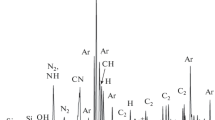Abstract
Weakly ionized, radio-frequency, glow-discharge plasmas formed from methyl ether or the vapors of a series of dimethyl oligo(ethylene glycol) precursors (general formula: H-(CH2OCH2)n-H;n=1 to 4) were used to deposit organic thin films on polytetrafluoroethylene. X-ray photoelecton spectroscopy (XPS) and static secondary ion mass spectrometry (SIMS) of the thin films were used to infer the importance of adsorption of molecular species from the plasma onto the surface of the growing, organic film during deposition. Films were prepared by plasma deposition of each precursor at similar deposition conditions (i.e., equal plasma power (W), precursor flow rate (F), and deposition duration), and at conditions such that the specific energy (energy/mass) of the discharge (assumed to be constrained byW/FM, whereM=molecular weight of the precursor) was constant. At constantW/FM conditions, two levels of plasma power (and, hence, twoFM levels) and three substrate temperatures were examined. By controlling the energy of the discharge (W/FM) and the substrate temperature, these experiments enabled the study of effects of the size and the vapor pressure of the precursor on the film chemistry. The atomic % of oxygen in the film surface, estimated by XPS, and the intensity of theC-O peak in the XPS Cls spectra of the films, were used as indicators of the degree of incorporation of precursor moieties into the plasma-deposited films. Analysis of films by SIMS suggested that these two measures obtained from XPS were good indicators of the degree of retention in the deposited films of functional groups from the precursors. The XPS and SIMS data suggest that adsorption of intact precursor molecules or fragments of precursor molecules during deposition can have a significant effect on film chemistry. Plasma deposition of low vapor pressure precursors provides a convenient way of producing thin films with predictable chemistry and a high level of retention of functional groups from the precursor.
Similar content being viewed by others
References
R. d'Agostino, ed.,Plasma Deposition, Treatment, and Etching of Polymers. Plasma-Materials Interactions Academic Press Inc., San Diego, (1990), p. 528.
G. P. Lopez and B. D. Ratner,Langmuir 7, 766 (1991).
G. P. Lopez and B. D. Ratner,J. Polym. Sci. Polym. Chem. Ed. 30, 2415 (1992).
G. P. Lopez, A. Chilkoti, B. D. Ratner, and D. J. Briggs,Polym. Sci. Polym. Chem. Ed. 30, 2427 (1992).
G. P. Lopez, B. D. Ratner, R. J. Rapoza, and T. A. Horbett,Macromolecules 26, 3247 (1993).
G. P. Lopez, B. D. Ratner, C. A. Tidwell, C. L. Haycox, R. J. Rapoza, and T. A. Horbett,J. Biomed. Mater. Res. 26, 415 (1992).
G. P. Lopez, B. D. Ratner, and D. Briggs,Trans. Soc. Biomat. 14, 277 (1991).
H. Yasuda and C. R. Wang,J. Polym. Sci. Polym. Chem. Ed. 23, 87 (1985).
D. T. Clark and M. Z. Abrahman,J. Polym. Sci. Polym. Chem. Ed. 20, 691 (1982).
D. T. Clark,Pure & Appl. Chem. 54, 415 (1982).
N. Inagaki, M. Doyama, and H. Igaki,J. Polym. Sci. Polym. Chem. Ed. 22, 2083 (1984).
N. Inagaki, H. Kobayashi, and K. Shimohira,Polym. Bull. 11, 29 (1984).
N. Inagaki and Y. Kubokawa,J. Polym. Sci. Polym. Chem. Ed. 27, 795 (1989).
A. Dilks, inElectron Spectroscopy: Theory, Techniques, and Applications, Vol. 4, A. D. Baker and C. R. Brundle, eds., Academic Press, London, (1981), p. 277.
M. J. Hearn and D. Briggs,Surf. Interface Anal. 9, 411 (1986).
A. Chilkoti, B. D. Ratner, and D. Briggs,Anal. Chem. 65, 1736 (1993).
D. Briggs, A. Brown, and J. C. Vickerman,Handbook of Static Secondary Ion Mass Spectrometry (SIMS), John Wiley and Sons, Chichester (1989).
A. Chilkoti, B. D. Ratner, and D. Briggs,Chem. Mater. 3, 51 (1991).
H. Yasuda,Plasma Polymerization, Academic Press, Inc., New York (1985).
Author information
Authors and Affiliations
Rights and permissions
About this article
Cite this article
López, G.P., Ratner, B.D. Molecular adsorption and the chemistry of plasma-deposited thin organic films: Deposition of oligomers of ethylene glycol. Plasma Pol 1, 127–151 (1996). https://doi.org/10.1007/BF02532823
Received:
Revised:
Issue Date:
DOI: https://doi.org/10.1007/BF02532823



